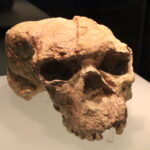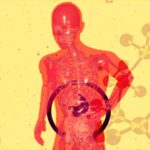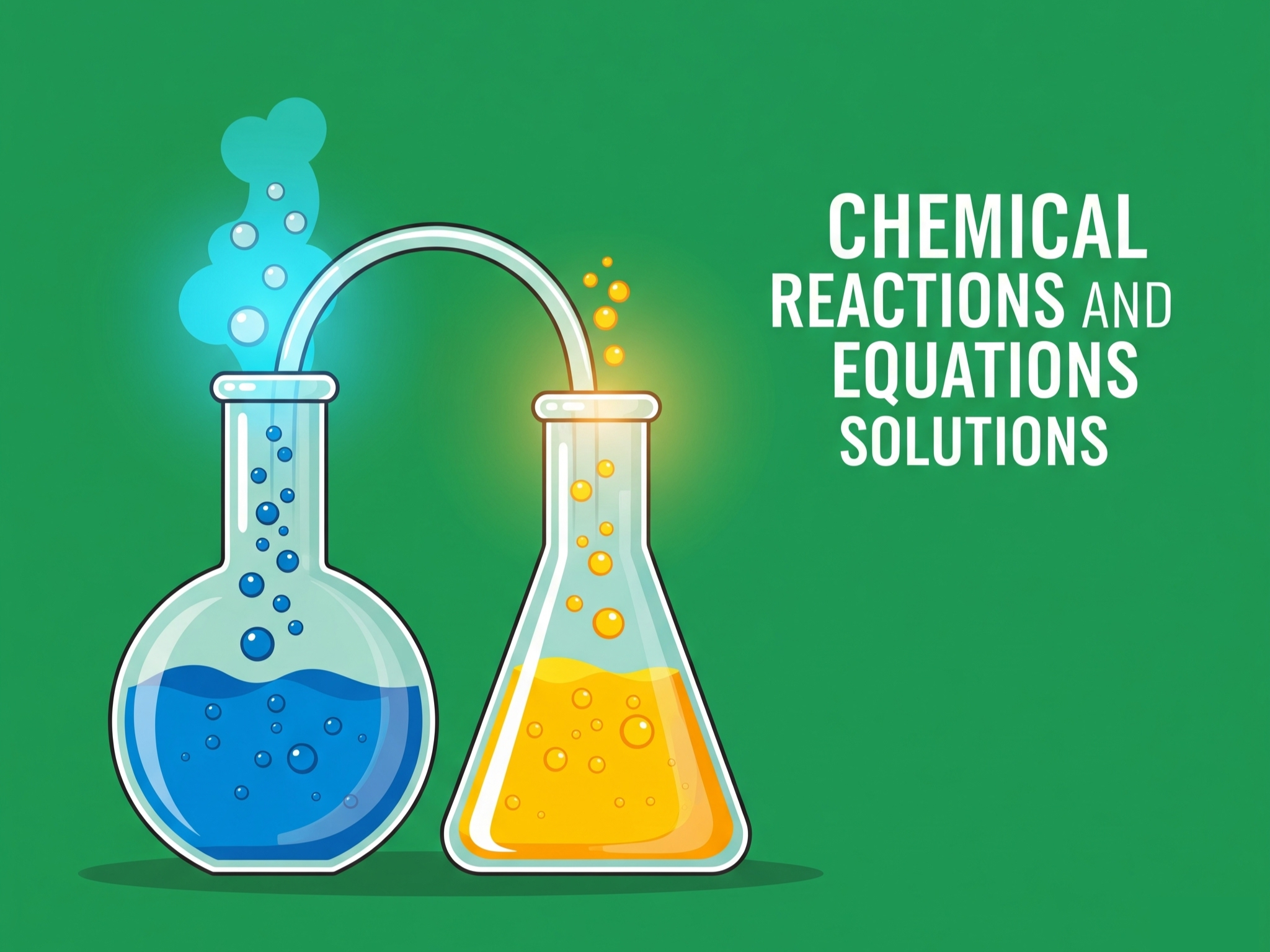Here are the comprehensive Chemical Reactions and Equations Solutions, based primarily on the NCERT textbook for the CBSE Class 10 Science syllabus, Chapter 1. These solutions cover all important in-text and end-of-chapter questions, providing clear, step-by-step answers aligned with the concepts explained in the textbook. Designed to help you understand and apply each topic effectively, the solutions include simplified explanations, properly balanced equations, and accurate classifications of chemical reactions. Whether you are revising for exams or practicing for a deeper understanding, this solution guide is your quick and reliable companion.

EXERCISES
1. Which of the statements about the reaction below are incorrect? 2PbO(s) + C(s) → 2Pb(s) + CO2(g)
(a) Lead is getting reduced. (Incorrect – Lead oxide is getting reduced to lead)
(b) Carbon dioxide is getting oxidised. (Incorrect – Carbon is getting oxidized to carbon dioxide)
(c) Carbon is getting oxidised. (Correct – Carbon gains oxygen to form CO2)
(d) Lead oxide is getting reduced. (Correct – Lead oxide loses oxygen to form Pb)
(i) (a) and (b)
(ii) (a) and (c)
(iii) (a), (b) and (c)
(iv) all
The incorrect statements are (a) and (b).
Answer: (i) (a) and (b)
2. Fe2O3 + 2Al → Al2O3 + 2Fe The above reaction is an example of a
(a) combination reaction.
(b) double displacement reaction.
(c) decomposition reaction.
(d) displacement reaction.
In this reaction, Aluminum (Al) displaces Iron (Fe) from Iron(III) oxide (Fe2O3). This is characteristic of a displacement reaction where a more reactive element displaces a less reactive element from its compound.
Answer: (d) displacement reaction.
3. What happens when dilute hydrochloric acid is added to iron fillings? Tick the correct answer.
(a) Hydrogen gas and iron chloride are produced.
(b) Chlorine gas and iron hydroxide are produced.
(c) No reaction takes place.
(d) Iron salt and water are produced.
When a metal reacts with an acid, hydrogen gas and a metal salt are typically produced. Iron reacts with hydrochloric acid to form iron chloride and hydrogen gas.
Answer: (a) Hydrogen gas and iron chloride are produced.
4. What is a balanced chemical equation? Why should chemical equations be balanced?
Answer:
A balanced chemical equation is an equation in which the number of atoms of each element is the same on both sides of the equation (reactant side and product side).
Chemical equations should be balanced to satisfy the Law of Conservation of Mass, which states that mass can neither be created nor destroyed in a chemical reaction. This means the total mass of the elements present in the products must be equal to the total mass of the elements present in the reactants. Consequently, the number of atoms of each element must remain the same before and after a chemical reaction.
5. Translate the following statements into chemical equations and then balance them.
(a) Hydrogen gas combines with nitrogen to form ammonia.
Answer:
- Unbalanced: H2(g) + N2(g) → NH3(g)
- Balanced: 3H2(g) + N2(g) → 2NH3(g)
(b) Hydrogen sulphide gas burns in air to give water and sulphur dioxide.
Answer:
- Unbalanced: H2S(g) + O2(g) → H2O(l) + SO2(g)
- Balanced: 2H2S(g) + 3O2(g) → 2H2O(l) + 2SO2(g)
(c) Barium chloride reacts with aluminium sulphate to give aluminium chloride and a precipitate of barium sulphate.
Answer:
- Unbalanced: BaCl2(aq) + Al2(SO4)3(aq) → AlCl3(aq) + BaSO4(s)
- Balanced: 3BaCl2(aq) + Al2(SO4)3(aq) → 2AlCl3(aq) + 3BaSO4(s)
(d) Potassium metal reacts with water to give potassium hydroxide and hydrogen gas.
Answer:
- Unbalanced: K(s) + H2O(l) → KOH(aq) + H2(g)
- Balanced: 2K(s) + 2H2O(l) → 2KOH(aq) + H2(g)
6. Balance the following chemical equations.
(a) HNO3 + Ca(OH)2 → Ca(NO3)2 + H2O
Answer:
Balanced: 2HNO3(aq) + Ca(OH)2(aq) → Ca(NO3)2(aq) + 2H2O(l)
(b) NaOH + H2SO4 → Na2SO4 + H2O
Answer:
Balanced: 2NaOH(aq) + H2SO4(aq) → Na2SO4(aq) + 2H2O(l)
(c) NaCl + AgNO3 → AgCl + NaNO3
Answer:
Balanced: NaCl(aq) + AgNO3(aq) → AgCl(s) + NaNO3(aq) (Already balanced)
(d) BaCl2 + H2SO4 → BaSO4 + HCl
Answer:
Balanced: BaCl2(aq) + H2SO4(aq) → BaSO4(s) + 2HCl(aq)
7. Write the balanced chemical equations for the following reactions.
(a) Calcium hydroxide + Carbon dioxide → Calcium carbonate + Water
Answer: Ca(OH)2(aq) + CO2(g) → CaCO3(s) + H2O(l)
(b) Zinc + Silver nitrate → Zinc nitrate + Silver
Answer: Zn(s) + 2AgNO3(aq) → Zn(NO3)2(aq) + 2Ag(s)
(c) Aluminium + Copper chloride → Aluminium chloride + Copper
Answer: 2Al(s) + 3CuCl2(aq) → 2AlCl3(aq) + 3Cu(s)
(d) Barium chloride + Potassium sulphate → Barium sulphate + Potassium chloride
Answer: BaCl2(aq) + K2SO4(aq) → BaSO4(s) + 2KCl(aq)
8. Write the balanced chemical equation for the following and identify the type of reaction in each case.
(a) Potassium bromide(aq) + Barium iodide(aq) → Potassium iodide(aq) + Barium bromide(s)
Answer:
- Equation: 2KBr(aq) + BaI2(aq) → 2KI(aq) + BaBr2(s)
- Type: Double Displacement Reaction
(b) Zinc carbonate(s) → Zinc oxide(s) + Carbon dioxide(g)
Answer:
- Equation: ZnCO3(s) → ZnO(s) + CO2(g)
- Type: Decomposition Reaction (Thermal decomposition)
(c) Hydrogen(g) + Chlorine(g) → Hydrogen chloride(g)
Answer:
- Equation: H2(g) + Cl2(g) → 2HCl(g)
- Type: Combination Reaction
(d) Magnesium(s) + Hydrochloric acid(aq) → Magnesium chloride(aq) + Hydrogen(g)
Answer:
- Equation: Mg(s) + 2HCl(aq) → MgCl2(aq) + H2(g)
- Type: Displacement Reaction
9. What does one mean by exothermic and endothermic reactions? Give examples.
Answer:
Exothermic Reactions: These are chemical reactions in which heat energy is released along with the formation of products. The temperature of the surroundings or the reaction mixture increases.
- Examples:
- Burning of natural gas: CH4(g) + 2O2(g) → CO2(g) + 2H2O(g) + Heat
- Slaking of lime (Calcium oxide reacting with water): CaO(s) + H2O(l) → Ca(OH)2(aq) + Heat
Endothermic Reactions: These are chemical reactions in which heat energy is absorbed from the surroundings. The temperature of the surroundings or the reaction mixture decreases, often feeling cold.
- Examples:
- Decomposition of calcium carbonate (limestone): CaCO3(s) Heat
CaO(s) + CO2(g)
- Photosynthesis: 6CO2(aq) + 6H2O(l) Sunlight
C6H12O6(aq) + 6O2(aq)
- Decomposition of calcium carbonate (limestone): CaCO3(s) Heat
10. Why is respiration considered an exothermic reaction? Explain.
Answer:
Respiration is considered an exothermic reaction because it involves the breakdown of glucose (food) in the presence of oxygen within our body cells to produce carbon dioxide, water, and energy. This energy is released in the form of ATP (adenosine triphosphate), which powers various life processes. Since heat energy is released during this biological process, it is classified as an exothermic reaction.
The balanced chemical equation for respiration is: C6H12O6(aq) + 6O2(aq) → 6CO2(aq) + 6H2O(l) + Energy
11. Why are decomposition reactions called the opposite of combination reactions? Write equations for these reactions.
Answer:
Decomposition reactions are called the opposite of combination reactions because of the fundamental change in the number of reactants and products:
- Combination Reactions: Two or more reactants combine to form a single product.
- General form: A + B → AB
- Equation Example: 2H2(g)+O2(g)→2H2O(l)
(Hydrogen and Oxygen combine to form water)
- Decomposition Reactions: A single reactant breaks down into two or more simpler products.
- General form: AB → A + B
- Equation Example: 2H2O(l)Electricity
2H2(g)+O2(g)
(Water decomposes into hydrogen and oxygen)
The products of one type of reaction can often be the reactants for the other type, demonstrating their opposite nature.
12. Write one equation each for decomposition reactions where energy is supplied in the form of heat, light or electricity.
Answer:
- Decomposition by Heat (Thermal Decomposition):
- CaCO3(s)Heat
CaO(s)+CO2(g)
- (Calcium carbonate decomposes into calcium oxide and carbon dioxide when heated.)
- CaCO3(s)Heat
- Decomposition by Light (Photolytic Decomposition):
- 2AgCl(s)Sunlight
2Ag(s)+Cl2(g)
- (Silver chloride decomposes into silver and chlorine gas in the presence of sunlight.)
- 2AgCl(s)Sunlight
- Decomposition by Electricity (Electrolytic Decomposition):
- 2H2O(l)Electricity
2H2(g)+O2(g)
- (Water decomposes into hydrogen and oxygen gases when electricity is passed through it.)
- 2H2O(l)Electricity
13. What is the difference between displacement and double displacement reactions? Write equations for these reactions.
Answer:
The main difference lies in the number of elements/compounds that swap places:
Displacement Reaction: A chemical reaction in which a more reactive element displaces or removes a less reactive element from its compound. Only one element displaces another.
- General Form: A + BC → AC + B (where A is more reactive than B)
- Equation Example: Zn(s)+CuSO4(aq)→ZnSO4(aq)+Cu(s)
- (Zinc displaces copper from copper sulphate solution because zinc is more reactive than copper.)
Double Displacement Reaction: A chemical reaction in which there is an exchange of ions between two reactant compounds, forming two new compounds. Two different atoms or groups of atoms (ions) are exchanged.
- General Form: AB + CD → AD + CB
- Equation Example: Na2SO4(aq)+BaCl2(aq)→BaSO4(s)+2NaCl(aq)
- (Sulphate ions from sodium sulphate and barium ions from barium chloride exchange to form barium sulphate precipitate and sodium chloride.)
14. In the refining of silver, the recovery of silver from silver nitrate solution involved displacement by copper metal. Write down the reaction involved.
Answer:
Since copper is more reactive than silver, it can displace silver from its salt solution. Cu(s) + 2AgNO3(aq) → Cu(NO3)2(aq) + 2Ag(s)
15. What do you mean by a precipitation reaction? Explain by giving examples.
Answer:
A precipitation reaction is a type of double displacement reaction where two soluble reactant solutions react to form an insoluble product called a precipitate, which separates out as a solid from the solution.
Examples:
- Reaction between Sodium Sulphate and Barium Chloride:
- Na2SO4(aq)+BaCl2(aq)→BaSO4(s)+2NaCl(aq)
- Here, Barium Sulphate (BaSO4) is the white precipitate formed, which is insoluble in water.
- Reaction between Lead Nitrate and Potassium Iodide:
- Pb(NO3)2(aq)+2KI(aq)→PbI2(s)+2KNO3(aq)
- Here, Lead Iodide (PbI2) is the yellow precipitate formed.
16. Explain the following in terms of gain or loss of oxygen with two examples each.
Answer:
(a) Oxidation Definition (in terms of oxygen): Oxidation is a chemical process involving the gain of oxygen by a substance. Examples:
- Burning of Carbon: Carbon gains oxygen to form carbon dioxide.
- C(s)+O2(g)→CO2(g)
- Formation of Copper(II) Oxide: Copper gains oxygen to form black copper(II) oxide.
- 2Cu(s)+O2(g)Heat
2CuO(s)
- 2Cu(s)+O2(g)Heat
(b) Reduction Definition (in terms of oxygen): Reduction is a chemical process involving the loss of oxygen by a substance. Examples:
- Reduction of Copper(II) Oxide: Copper(II) oxide loses oxygen to form copper.
- CuO(s)+H2(g)Heat
Cu(s)+H2O(l)
- CuO(s)+H2(g)Heat
- Reduction of Zinc Oxide: Zinc oxide loses oxygen to form zinc.
- ZnO(s)+C(s)→Zn(s)+CO(g)
17. A shiny brown coloured element ‘X’ on heating in air becomes black in colour. Name the element ‘X’ and the black coloured compound formed.
Answer:
- The shiny brown colored element ‘X’ is Copper (Cu).
- When heated in air, copper reacts with oxygen to form a black colored compound.
- The black colored compound formed is Copper(II) oxide (CuO).
The reaction is: 2Cu(s)+O2(g)Heat2CuO(s)
18. Why do we apply paint on iron articles?
Answer:
We apply paint on iron articles primarily to prevent corrosion, specifically rusting. Rusting occurs when iron articles are exposed to moisture and oxygen in the air, leading to the formation of reddish-brown hydrated iron(III) oxide (rust). The paint acts as a protective barrier, preventing direct contact between the iron surface and oxygen and moisture, thereby slowing down or stopping the rusting process.
19. Oil and fat containing food items are flushed with nitrogen. Why?
Answer:
Oil and fat containing food items are flushed with nitrogen to prevent rancidity. Rancidity is caused by the oxidation of fats and oils present in the food, which leads to changes in their smell and taste (they become stale or rotten). Nitrogen is an inert gas (unreactive) and acts as an antioxidant. By flushing the food packages with nitrogen, the oxygen (which causes oxidation) is displaced, thereby preventing or significantly slowing down the oxidation of fats and oils and keeping the food fresh for a longer period.
20. Explain the following terms with one example each.
Answer:
(a) Corrosion
- Definition: Corrosion is the process by which metals are gradually eaten away or destroyed when they react with substances around them, such as moisture, acids, gases, etc., over a period of time. It is essentially an oxidation process.
- Example: Rusting of Iron: When iron articles are exposed to moist air for a prolonged period, a reddish-brown flaky substance called rust (hydrated iron(III) oxide, Fe2O3⋅xH2O) is formed on their surface. This weakens the iron and is a common example of corrosion.
(b) Rancidity
- Definition: Rancidity refers to the spoilage of food items (especially those containing fats and oils) when they are exposed to air (oxygen) for a long time. This exposure leads to the oxidation of fats and oils, which changes their smell and taste, making them unpleasant to consume.
- Example: If chips, biscuits, or fried snacks are left exposed to the air for several days, they develop an unpleasant smell and taste due to the oxidation of the oils and fats present in them, making them rancid.







